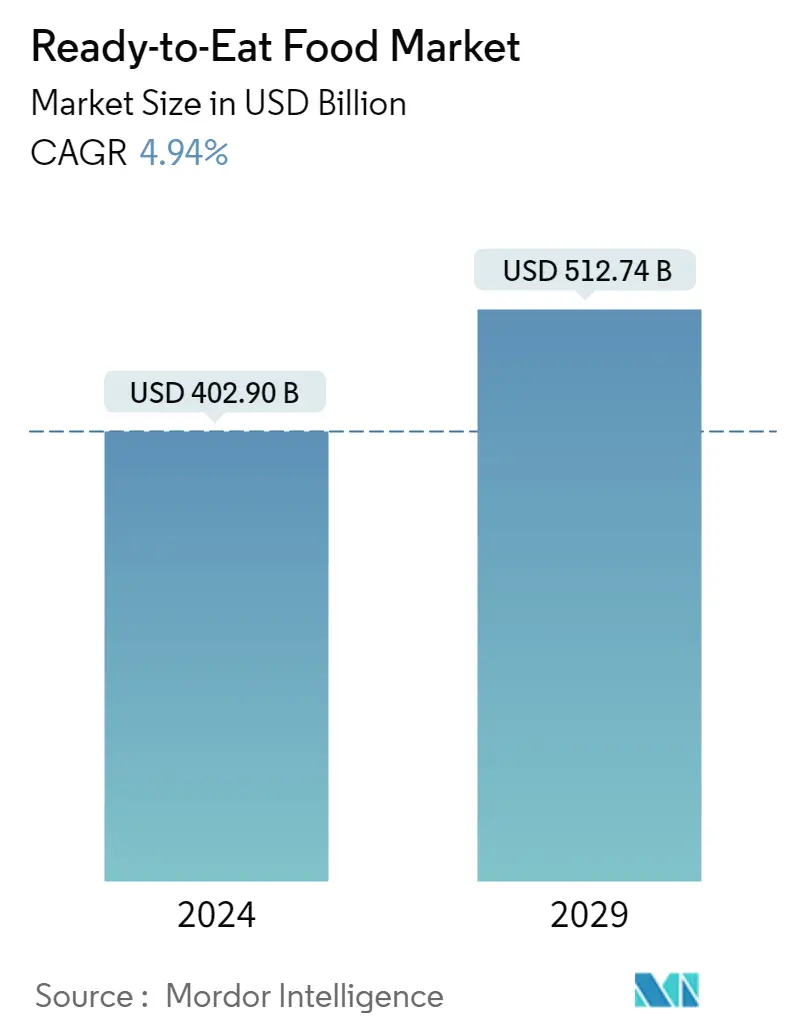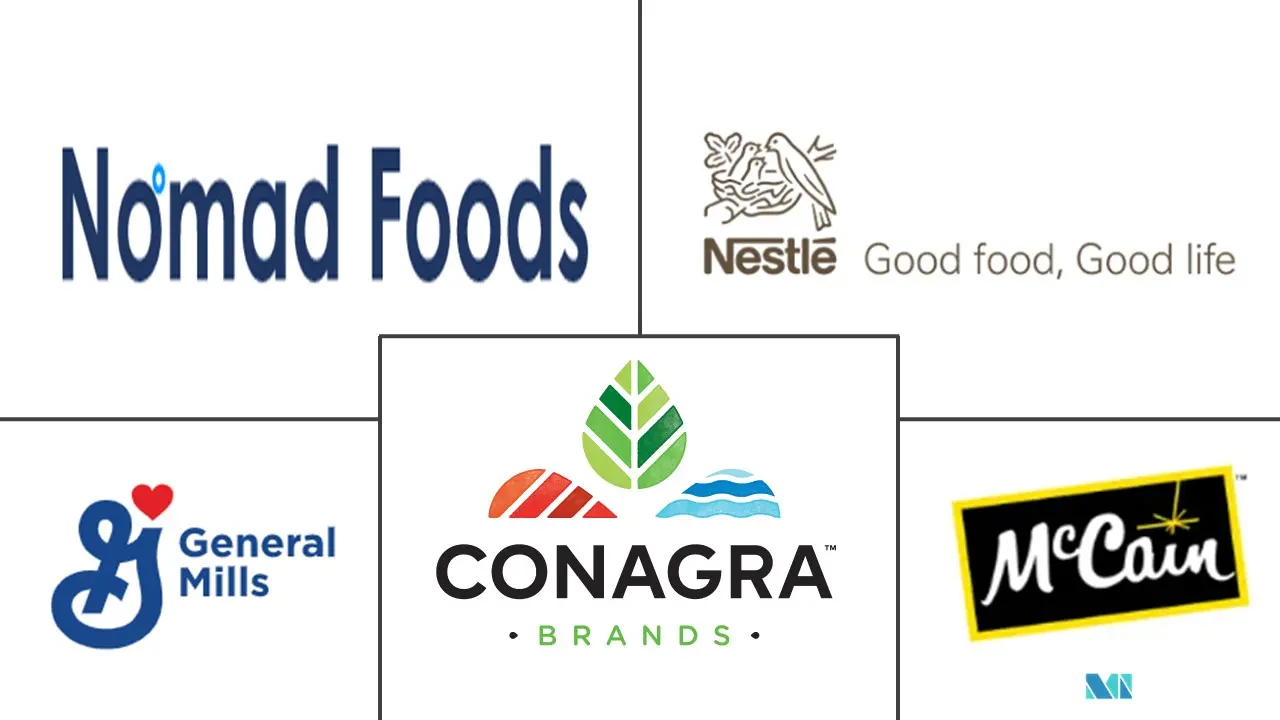Market Size of Ready-to-Eat Food Industry

| Study Period | 2019 - 2029 |
| Market Size (2024) | USD 402.90 Billion |
| Market Size (2029) | USD 512.74 Billion |
| CAGR (2024 - 2029) | 4.94 % |
| Fastest Growing Market | South America |
| Largest Market | Asia-Pacific |
Major Players
*Disclaimer: Major Players sorted in no particular order |
Ready to Eat Food Market Analysis
The Ready-to-Eat Food Market size is estimated at USD 402.90 billion in 2024, and is expected to reach USD 512.74 billion by 2029, growing at a CAGR of 4.94% during the forecast period (2024-2029).
- The market is witnessing a shift in consumer preferences from home-cooked food to ready-to-eat products, owing to working individuals' busy lifestyles and hectic work schedules. This change in consumer behavior will likely uplift the market studied significantly in the forecast period. Ready-to-eat products are considered the closest alternative to regular food, which can be consumed at any time (such as during breakfast, lunch, or dinner).
- Consumer interest in new products and ingredients is rising and is expected to witness positive developments. Besides traditional cuisine, consumers are eager to try different meals from other ethnicities, such as Indian, Thai, and Italian. Therefore, preference for ethnic ready-to-eat food has driven the demand for these products.
- Millennials and the young generation are the easiest targets for ready-to-eat food manufacturing giants as they spend most of their income on such food products. Thus, such products' convenience level is increasing the global market's total demand. Furthermore, the rising health consciousness among consumers, the predominance of lifestyle disorders, and the nutritional value associated with fresh food are restraining the ready-to-eat food products markets.
Ready to Eat Food Industry Segmentation
Ready-to-eat foods are foods made for direct consumption and do not require much further processing. They are mostly consumed without prior preparation or cooking. The ready-to-eat food market is segmented by product type, distribution channel, and geography. Based on product type, the market is segmented into instant breakfast/cereals, instant soups and snacks, ready meals, baked goods, meat products, and other product types. Based on the distribution channel, the market is segmented into hypermarkets/supermarkets, convenience stores, online retail stores, and other distribution channels. Moreover, the study analyzes the ready-to-eat food market across geography, including North America, Europe, Asia-Pacific, South America, the Middle East, and Africa. For each segment, the market sizing and forecasts have been done on the basis of value (in USD million).
| Product Type | |
| Instant Breakfast/Cereals | |
| Instant Soups and Snacks | |
| Ready Meals | |
| Baked Goods | |
| Meat Products | |
| Other Product Types |
| Distribution Channel | |
| Hypermarkets/Supermarkets | |
| Convenience Stores | |
| Online Retail Stores | |
| Other Distribution Channels |
| Geography | |||||||||
| |||||||||
| |||||||||
| |||||||||
| |||||||||
|
Ready-to-Eat Food Market Size Summary
The ready-to-eat food market is experiencing significant growth, driven by a shift in consumer preferences towards convenience due to busy lifestyles. This trend is particularly evident among millennials and the younger generation, who are increasingly opting for ready-to-eat products over traditional home-cooked meals. The market is expanding as consumers show a growing interest in trying new and ethnic cuisines, such as Indian, Thai, and Italian, which has further fueled demand. However, the market also faces challenges from rising health consciousness and lifestyle disorders, which may impact the consumption of ready-to-eat foods. The global demand for instant and convenient food options, including snacks, pasta, and meat products, is on the rise, supported by changes in social and economic patterns and increased food expenditure.
Asia-Pacific leads the ready-to-eat food market, with countries like China and India driving demand for frozen and ready meals. The market is characterized by the introduction of exotic products, private label influx, and product premiumization, which are enhancing consumer perception of ready meals. The presence of key players such as Nomad Foods Ltd, General Mills, McCain Foods, Nestle SA, and Conagra Brands intensifies competition, with companies focusing on product innovation, strategic expansions, and geographic growth to maintain a competitive edge. The market's competitive landscape is further shaped by strategic acquisitions and product launches, such as McCain Foods' acquisition of Scelta Products and General Mills' introduction of prepared meal kits, which aim to cater to evolving consumer preferences and enhance market share.
Ready-to-Eat Food Market Size - Table of Contents
-
1. MARKET DYNAMICS
-
1.1 Market Drivers
-
1.2 Market Restraints
-
1.3 Porter's Five Forces Analysis
-
1.3.1 Threat of New Entrants
-
1.3.2 Bargaining Power of Buyers/Consumers
-
1.3.3 Bargaining Power of Suppliers
-
1.3.4 Threat of Substitute Products
-
1.3.5 Intensity of Competitive Rivalry
-
-
-
2. MARKET SEGMENTATION
-
2.1 Product Type
-
2.1.1 Instant Breakfast/Cereals
-
2.1.2 Instant Soups and Snacks
-
2.1.3 Ready Meals
-
2.1.4 Baked Goods
-
2.1.5 Meat Products
-
2.1.6 Other Product Types
-
-
2.2 Distribution Channel
-
2.2.1 Hypermarkets/Supermarkets
-
2.2.2 Convenience Stores
-
2.2.3 Online Retail Stores
-
2.2.4 Other Distribution Channels
-
-
2.3 Geography
-
2.3.1 North America
-
2.3.1.1 United States
-
2.3.1.2 Canada
-
2.3.1.3 Mexico
-
2.3.1.4 Rest of North America
-
-
2.3.2 Europe
-
2.3.2.1 Spain
-
2.3.2.2 United Kingdom
-
2.3.2.3 Germany
-
2.3.2.4 France
-
2.3.2.5 Italy
-
2.3.2.6 Russia
-
2.3.2.7 Rest of Europe
-
-
2.3.3 Asia-Pacific
-
2.3.3.1 China
-
2.3.3.2 Japan
-
2.3.3.3 India
-
2.3.3.4 Australia
-
2.3.3.5 Rest of Asia-Pacific
-
-
2.3.4 South America
-
2.3.4.1 Brazil
-
2.3.4.2 Argentina
-
2.3.4.3 Rest of South America
-
-
2.3.5 Middle-East and Africa
-
2.3.5.1 South Africa
-
2.3.5.2 Saudi Arabia
-
2.3.5.3 Rest of Middle-East and Africa
-
-
-
Ready-to-Eat Food Market Size FAQs
How big is the Ready-to-Eat Food Market?
The Ready-to-Eat Food Market size is expected to reach USD 402.90 billion in 2024 and grow at a CAGR of 4.94% to reach USD 512.74 billion by 2029.
What is the current Ready-to-Eat Food Market size?
In 2024, the Ready-to-Eat Food Market size is expected to reach USD 402.90 billion.

